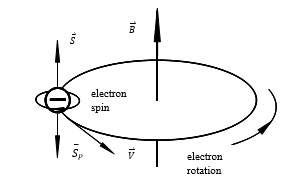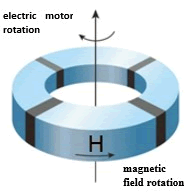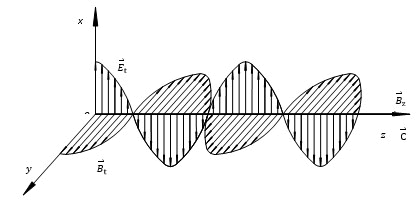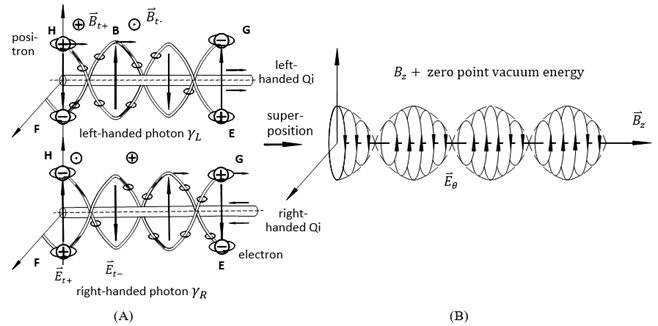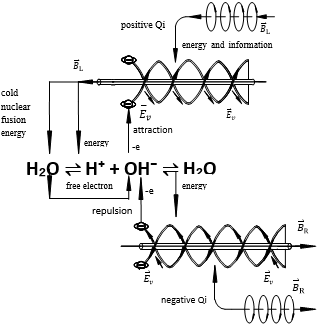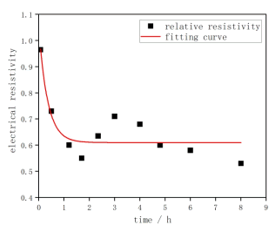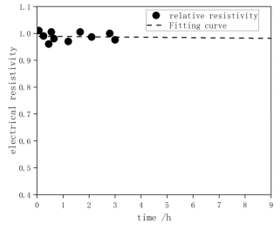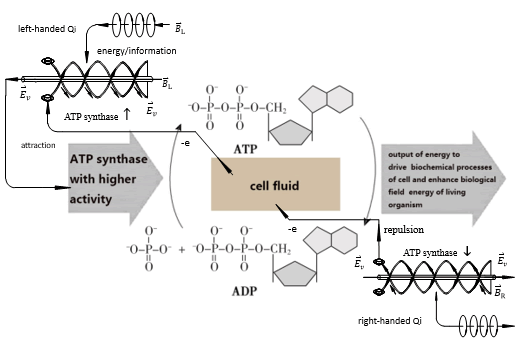Research Article - Journal of Evolutionary Medicine ( 2024) Volume 12, Issue 6
Wave equations and particle propagation model of TCM (traditional Chinese medicine) Qi and its interaction with water
Jiang Jianzhong1* and Chen Xingyu22Wuxi Foreign Language School, Wuxi 214001, China
Jiang Jianzhong, Institute of Mechanics, Jiangnan University, Wuxi 214122, China, Email: 8043000163@jiangnan.edu.cn
Received: 12-Jun-2024, Manuscript No. JEM-24-138567; Editor assigned: 14-Jun-2024, Pre QC No. JEM-24-138567 (PQ); Reviewed: 28-Jun-2024, QC No. JEM-24-138567; Revised: 03-Jul-2024, Manuscript No. JEM-24-138567 (R); Published: 10-Jul-2024, DOI: 10.4303/JEM/138567
Abstract
Based on the fluid vortex theory and the assumption that the positive and negative photon components undergo double helix motion, we have proposed the wave equations and neutrino propagation model for Qi of TCM and its interaction mode with water/amino acid. These new models effectively elucidate the biochemical mechanism of TCM Qigong biotherapy, providing theoretical support for its further clinical trials. By understanding Qi from the perspective of torsion field and scalar wave, it is possible to resolve all associated issues with Qi easily. Hence, we propose that Qi, torsion field and scalar wave are synonymous. A large number of experimental studies have confirmed that Qi can be absorbed by water, induce weakly alkaline, small molecular structured water with enhanced conductivity. Moreover, by promoting free electrons in cell fluid to move into cell membrane and improving mitochondrial efficiency and antioxidant effect, Qi can lead to increased mitochondrial ATP concentration and enhanced the energy of biological field of organisms.
Keywords
TCM Qigong therapy; Energy medicine; Scalar wave; Neutrino; Torsion field
Introduction
The concept of Qi in traditional Chinese medicine refers to an objectively existing substance with energetic properties [1]. Guo Pu, et al. was the first to introduce the concept of Qi during the Jin Dynasty in China [2]. He proposed that “Qi disperses with the wind and stops with water”. In recent years, there has been a growing interest in investigating the enigmatic energy of Qi, some scholars even integrate Qi into the innovation of novel products [3]. It has been reported that several countries have successfully applied Qi in sports and achieved tangible results [4]. Due to its association with consciousness, there is currently no comprehensive theoretical model available to accurately characterize it, leading many scholars to question its existence. However, scientific experiments have demonstrated the existence of Qi and its measurability. Lee Sichen, et al. found that positive Qi (such as when Qigong teachers are mindful) can enhance protein synthesis rates while negative Qi (such as when Qigong teachers are confused) can diminish them [5]. Furthermore, through nuclear magnetic resonance experiments, he confirmed that water is capable of absorbing energy from Qi, which leads to a disruption of hydrogen bonds between water molecules and subsequently produces smaller water molecule groups [6]. Similarly, Mr. Sasaki Masami verified the existence of Qi by measuring the conductivity of Qigong water [4], discovering that positive Qi increases water conductivity, while negative Qi decreases it; however, Qi does not affect the pH value of water. By converting Qigong water into a film and subjecting it to infrared radiation, he observed changes in the resonance state of water molecules where only binding strength increased without altering covalent bond angles and lengths. He proposed that Qi may interact with neutrons within structured water molecules, cause chemical changes and release energy activating bound electron in water to be free one, which aligns with Professor Jiang Xingliu’s hypothesis regarding extracting zero-point vacuum energy through vortex-torsion field (TF) interaction [7]. To elucidate further on this essence of Qi we aim at combining Qi with Scalar Wave (SW), TF and establishing rigorous particle propagation model and wave equations for Qi thus laying down solid theoretical groundwork for its clinical application studies.
Methods
The relation between Qi and TF and SW
Kozyrev introduced a significant concept known as Torsion Field (TF) [8]. He posited that a fixed spin should have relation to a spin field-TF like a fixed particle mass to a gravitational field and a fixed charge to an electromagnetic field. However, due to the fact that the static force of the TF is even much smaller than the gravitational force, in his general theory of relativity Einstein chose to overlook it in order to simplify theoretical derivations. The distortion of spacetime caused by TF resembles that in a gravitational field and cannot be shielded by any natural substance. Furthermore, it has been found that TF can stimulate cold nuclear fusion to extract zero-point vacuum energy [7-9]. Liang Weichich has theoretically proven how to trigger TF [10]. When an electron’s spin magnetic moment S aligns with an applied magnetic field B ï¶ , simultaneously rotating at specific frequency along a large circle-orbit perpendicular to B ï¶ (Figure 1). This results in cyclotron resonance and transfer of substantial energy from B ï¶ to the electron, which is called as “coupling of particle spin with orbital revolution” underlying the generation mechanism of TF. Kozyrev, et al. invented a rotating TF generator, utilizing a nickel-manganese iron ring magnet as its crucial component [11]. As depicted in Figure 2, the magnetic field H rotates counterclockwise seen from top to bottom. When the magnetic ring is driven to rotate clockwise by the motor, it produces a right-handed TF (resulting in negative Qi). Conversely, if the magnetic ring rotates counterclockwise, it generates a left-handed TF (producing positive Qi). According to the research of Lee Sichen [11], when the magnet of Sphilman’s TF generator spins at over 3,000 rotations per minute, the spins of its magnetic molecules align neatly in rows and form a large circle along the center of the magnet. These particles (magnetic molecules) spins can create micro-holes in spacetime that converge at the center of the ring magnet to form a large circular hole. The twisted space-time torn by these micro-holes will twist nearby space-time and rotate with it, forming an axial twisted space-time sword with an influence range extending up to two or three meters. Individuals sensitive to meridians can perceive tingling sensations caused by this Qi field and experience increased Qi and blood circulation within their bodies. Remarkably, even though a two-centimeter thick aluminum plate cannot block this Qi field, but wet paper by water can completely absorb it. This aligns with Guo Pu’s statement: “Qi stops with water”. Therefore, we may boldly hypothesize that TF is traditional Chinese medicine’s Qi [1-4]. There is another entity named as SW related to Qi, which has faced similar challenges as TF. Initially, Maxwell theoretically discovered the existence of SW [12]. However, in an effort to simplify calculations, Hertz disregarded the longitudinal wave term (SW) of electromagnetic waves. Subsequently, Nikola Tesla proved the existence of SW through experiments [13]. Due to SW’s exceptional characteristics such as lossless penetration of the human body, superluminal speed, absorption of free energy and lossless energy propagation [14,15], their potential and practical applications in medicine and energy areas have been widely recognized [16-20]. A careful analysis reveals that Qi, TF and SW share common traits: 1. They appear to interact with human consciousness; 2. They can convey information and energy; 3. They possess medical properties; 4. They are challenging to measure; 5. They are linked to zero-point vacuum energy; 6. Their underlying principles remain unknown. Consequently, many scholars contend that three entities are synonymous [6-8]. By understanding Qi from the perspective of TF and SW, it is possible to resolve all associated issues with Qi easily.
Figure 1: Schematic diagram of coupling of electron spin and orbital rotation
Figure 2: Schematic diagram of Sphilmanâ??s rotary TF generator
Particle propagation model of Qi
The similarity between Qi (SW, TF) and neutrino: Neutrinos are characterized by their superluminal velocities [21] and inability to decay into other particles, possessing an infinite lifetime. Notably, neutrinos exhibit left-handedness [22] as depicted in Figure 3. Furthermore, they propagate without energy loss and possess remarkable penetration due to neatly negligible participation in electromagnetic and strong nuclear forces [23]. A lot of investigations on SWs have revealed striking similarities between them and neutrinos (Table 1). In light of the double helix structure model of photon [24], we can confidently hypothesize that neutrinos are highly plausible candidates for propagating SWs.
Table 1: The similarity of SW and neutrino
|
|
Excellent penetration property [23] | Electromagnetic characteristics [14,15] | Lossless energy transmission | Wave-length [22] | Mass |
|---|---|---|---|---|---|
| Neutrino | The cross section action area with atomic nucleus is 10-43 cm2 | Weak interaction only | Energy loss of One in 10 billion | = 10-15 m | Too small to detect |
| SW | SW frequency >>1019 Hz | Non-Hertz wave | Energy is lossless | 10-22 m | No quality |
Figure 3: Left-handedness and right-handedness of neutrinos
Neutrino propagation model for Qi: Based on the hypotension that 1) a photon possesses an electric structure consisting of a positron and an electron; 2) positron and electron spire forward around propagation axis, while their core advances at the speed C along the direction of photon propagation [24], a double helix model is developed to represent photon, as illustrated in Figure 4. The left-handed photon model is depicted in Figure 4B, where positron exhibits right-handed spin while moving along a right-handed spireorbit around the forward axis, generating left-handed Qi BZ+. Similarly, in Figure 4(B) electron possesses left-handed spin while moving along a left-handed spire-orbit around the forward axis, producing left-handed Qi BZ-. According to Qi-generation mechanism of coupling of particle spin with orbital rotation [10], positron produces the same kind of Qi as electron, i.e., Bz− = Bz+ . The total Qi generated by the helical motions of the two kinds of photon components can be represented as Bz= Bz− + Bz+ . The schematic diagram illustrating TEM waves and Qi (SW) generated in a vacuum by positron and electron is presented in Figure 5. The righthanded photon model is illustrated in Figure 4(A), with a similar principle analysis as left-handed photon. Based on the aforementioned analysis, photons can be categorized into two groups based on their spin direction: Left-handed photon (producing left-handed Qi) and right-handed photon (producing right-handed Qi). In order to maintain the angular momentum conservation of the Qi neutrino model, the Qi particle model should consist of two neutrinos with reversely orbital rotation. Figure 6(A) represents the left-handed Qi neutrino model composed of two neutrinos with left-handed spin. The neutrino spin velocity is the speed of light, and both of them move in a left-handed large spiral orbit along the forward axis, and the axial velocity is also the speed of light. The phase difference between the two neutrinos is π, and the total Qi is BL, representing a high energy state. The right-handed Qi neutrino model is shown in Figure 6(B), which is also composed of two neutrinos with left-handed spin, but moving in a right-handed large spiral orbit around the forward axis. Their phase difference is also π, and the total Qi is BR, representing a low energy state. According to the right-handed rule of electromagnetic induction [25], lefthanded BL produces the left-handed electric vortex potential Ev (Figure 7). In accordance with the vortex theory of fluid dynamics [26], vortices attract in the same spin direction and repel in the opposite spin direction. Therefore, the lefthanded BL attracts the left-handed Qi, and right-handed BR attracts the right-handed Qi see (Figure 8).
Figure 4: (A)Right-handed photon structure (B) Left-handed photon structure
Figure 5: SW (Qi) and TEM waves in a vacuum
Figure 6: (A) Right-handed Qi structure (B) Left-handed Qi structure
Figure 7: (A) Superposition of left-handed photon/right-handed photon (B) A schematic diagram of the propagation of SW(Qi)
Figure 8: Spin-selectivity and interaction between Qi
Generation mechanism of Qi from particle perspective
In general, SW (Qi) is usually allowed to be neglected due to their significantly smaller amplitude compared with that of TEM wave. But in certain scenarios such as the near field [27], current Maxwell’s equations fail to fully elucidate the characteristics of them. Hence, consideration must be given to SW. The generation of SW typically occurs when two coherent TEM waves with identical frequency, amplitude, propagation direction, and a phase difference π superposed in a vacuum (referred to as “source waves”). After superposition, the resulting total Et electromagnetic field Bt can be shown as


Here, the electric field components of the two source waves are denoted as E1 and E2 respectively, while their corresponding magnetic field components are represented by B1 and B2. From Eq. (1) and Eq. (2), after superposition Et and Bt become zero, seemingly vanish into vacuum. However, in accordance with the principle of energy conservation, all energy of source waves is actually transferred to the SW Bz. This energy transfer can be explained by definitions of magnetic vector potential A and scalar potential φ [28].

Here, ψ represents a scalar field known as the “zero-point vacuum energy field” [29], “torsion field” [30], or “neutrino field”. This phenomenon can be mutually corroborated by the Aharov-Bohm effect [31], which highlights the significance of A and φ in comparison to Et and Bt. Our photonic structure model can effectively elucidate the essence of this phenomenon. The superposition of two source waves is equivalent to the superposition of a left-handed photon γL and a right-handed photon γR. As depicted in Figure 7, at points E and H, positrons from γL meet with electrons from γR; conversely, at points G and F, electrons from γL encounter positrons from γR. Their superposition leads to an annihilation involving positrons/electrons [32], giving rise to Bz and releasing substantial zero-point vacuum energy. This reaction can be mathematically expressed as follows

At this stage, although source TEM fields Et and Bt vanish in space, both magnetic vector potential A and scalar potential φ still persist and consist of SW (Qi); where
Generation mechanism of Qi from wave perspective
In the previous part, we explored the generation mechanism of SW (Qi) from the perspective of particle. Next, we will explore the SW (Qi) from the perspective of wave and analyze the physical nature of Qi’s ability to absorb zeropoint vacuum energy. The scalar potential φ and magnetic vector potential [28] A of electromagnetic fields in a stationary vacuum can be expressed as φ=φ0 exp [j (k. r − ωt)] and A = A0 exp [j ( k. r −ωt)], where k is wave vector and

From Lorentz gauge [28], it is given that

According to the relations [28] of electromagnetic fields with φ and A as well as Eq.(5.1), Eq.(6), it is obtained that

Multiplying both sides of Eq.(7) by ∇ operator and considering C as constant vectors, we can obtain in a vacuum
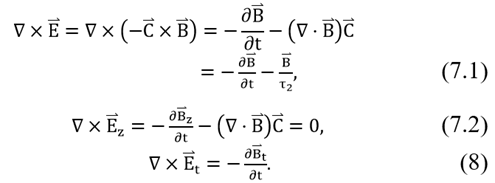
According to the total current law in a vacuum, it is given that

and

Here, σ0,ε0 are electric conductivity and dielectric constant in a vacuum, and τ1, τ2are the decay time of eddy current and electric vortex potential caused by TEM wave in the wave propagation medium [14].
According to Eq. (7.1), Eq. (9), and energy equation and energy conservation law of electromagnetic wave [28] in a vacuum region Ω, the total energy ET from the two columns of source waves should be equal to the SW energy EPafter their superposition, i.e.,
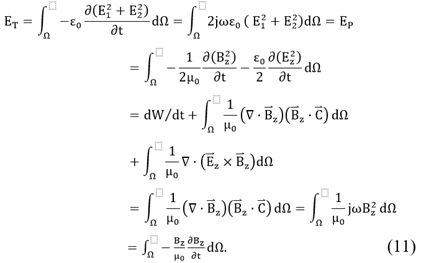
Here, dW⁄dt represents the work performed by the electromagnetic force on all free charges within Ω per unit time, there is no charge in a vacuum, i.e., dW⁄dt = 0; ∇.
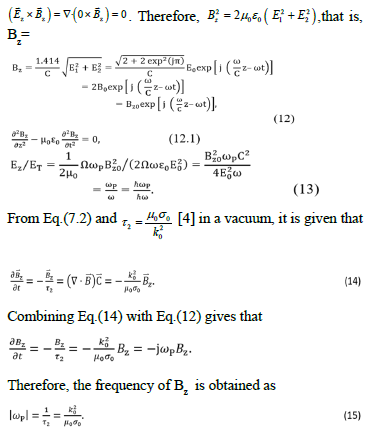
Here, μ0 denotes vacuum magnetic permeability, and k0 is a constant related to TEM wave frequency.
With reference to the basic equations of vacuum TEM wave

vacuum electric longitudinal wave equation can be expressed as

From Eq.(10), it is obtained that ∇·E = jkEz = 0, i.e., E is passive,and then we have

Substituting Eq. (15.2) into Eq. (15.1) gives

and

Eq. (12) and Eq. (15.3) are the plane solutions of wave equations of Qi in a vacuum. A schematic diagram of the propagation of Qi is shown in Figure 7(B), where the electromagnetic longitudinal wave Eθ and BZ are interconverted and forward propagating along the z-axis at the speed of light C.
In Eq. (15), taking σ0=0 gives ω P ω = ∞ >> ωω in a vacuum, which means the SW energy Ez is significantly greater than the total energy ET of source TEM waves and z B must derive additional energy produced by the annihilation of positrons/electrons in a vacuum. The energy flow chart of SW (Qi) is illustrated in Figure 9(A). The energy produced by the annihilation of positrons/electrons is called as “zeropoint vacuum energy”. Synthesizing above analysis and derivation, we surprisingly find that the unification of waveparticle duality of light is achieved when examined at the level of Qi.
Figure 9: (A) Energy flow chart of SW(Qi), (B) The changes of O17 half height and width of physiological saline after direct irradiation of Qi field [6]
The impact of Qi on the electrical conductivity of water
The degree of water ionization is influenced by temperature, pressure, solute concentration, acidity and alkalinity, as well as other factors such as electromagnetic fields and light. Ultraviolet rays can increase water ionization through photolysis reaction. Positive gas (left-handed SW BL) entering water provides energy for the ionization process and forms a left-handed vortex potential channel (vortex induced electric field Ev, (Figure 10). The free electrons (hydroxide ions) with left-handed spin in water are attracted by Ev to make left-handed movement along this spiral channel, thus accelerating the ionization of water molecules and increasing the concentration of hydrogen ions in water. Moreover, this vortex movement is also coherent with TF to extract the zero point energy, producing high-energy rays, neutrons and high-energy particles in the vortex center, accompanied by highly directional cold nuclear fusion [9,31]. On the one hand, the huge energy released by this process first breaks the fragile hydrogen bonds between water molecules (bond energy 23 kJ/mol, 0.24 eV) and produces small molecule groups of water. At the same time, it enhances the HO-H covalent bond energy of water molecules (bond energy 492 kJ/mol, 5.10 eV) [4]. On the other hand, it makes the bound electrons of water molecules be extremely active and become free electrons [4]. The increase of free electron concentration will weaken the ionization of water molecules, and finally form an ionization equilibrium state, which can increase the conductivity of water without affecting the PH value, and finally form high conductivity, weak alkalinesmall molecule group-high energy state water. If negative Qi (SW BR) enters water, BR produces a right-handed vortex potential (Figure 10) channel in water, which is a heatabsorbing process that respells free electrons, accelerating the reverse ionization process of water molecules, reducing the concentration of free electrons and hydrogen ions in water, decreasing water conductivity, and causing the water to be in a low energy state. Mr. Sasaki Masami proved the existence of Qi by measuring the conductivity of Qigong water [4]. His experimental results are shown in Figures 11 and 12: The conductivity of water treated by positive Qi is increased and the resistivity is decreased (Figure 11); the conductivity of water without Qi is basically unchanged (Figure 12).
Figure 10: Schematic diagram of the influence of Qi on water conductivity
Figure 11: The conductivity of water with positive Qi
Figure 12: The conductivity of water without Qi
The interaction between Qi and cell fluid/ATP synthase in living organisms
ATP (adenosine triphosphate) in mitochondria is a crucial cellular energy source. When ATP is hydrolyzed back to ADP (adenosine diphosphate) and Pi (inorganic phosphate), energy is released to drive many biochemical processes within the cell, thereby stimulating, balancing and enhancing the energy of the biological field of life and restoring the body’s health. Therefore, the alteration of the ATP/ADP ratio is intricately linked to apoptosis, cellular autophagy, energy metabolism, and numerous other pathways, and is frequently utilized as a key indicator of cellular activity. Electron transfer plays a central role in fundamental life processes such as photosynthesis and respiration, facilitated by proteases composed of long chains connected by left-handed amino acid molecules. When the living organism consumes positive Qigong water (containing the left-handed Qi BL) or receives drug or nutritional information and energy carried by BL, BL induces a left-handed electric vortex potential Ev channel on the long chain of ATP synthase. Ev attractes lefthanded free electrons in the cellular fluid to move along this long chain. Simultaneously, enrichment of free electrons on the cell membrane improves catalytic efficiency of ATP synthase, then accelerates ATP synthesis (Figure 13). This leads to an increased ATP/ADP ratio in cell and a high-energy state for the organism. When positive energy is insufficient in the living body, which will produces right-handed Qi BR in the center of the long chain of ATP synthase, which produces right-handed electric vortex potential Ev. Ev repelles the lefthanded free electrons and promoting them to move from the long chain to cell liquid. Meanwhile, the release of free electrons also decreases the catalytic efficiency of ATP synthase, which accelerates the chemical reaction speed of ATP hydrolysis, and then reducing the concentration ratio of ATP/ADP in mitochondria, so that the living body is in a low energy state. Additionally, some studies [33,34] have shown that there are numerous tunnel nanotubes in the cell membrane, through which mitochondrial connections act as biological signal waveguides to facilitate the exchange of energy and information between cells via electrical or magnetic means. These findings also support the interaction mechanism between Qi and water/ATP synthase in living organisms.
Figure 13: ATP/ADP mutual conversion in mitochondria of cells under the action of Qi
Validation of the increasing concentration of ATP in the mitochondria generated by positive Qi
Schnabl H, et al. conducted a study using a Tesla SW generator (10 mW, 6.7 MHz, (Figure 14) to investigate the effects of Qi (SW) on plant growth [33,34]. Their research revealed that the left-handed SW (positive Qi) signal led to a 40% increase in ATP content in the mitochondria of Ephorbia pulcherrima (10 mW, 90 seconds, red columns in contrast to blue controls, (Figure 14). Additionally, it extended their lifespan by almost 10%. They observed the noticeable difference in color between treated/untreated flowers at the same stage. Two Ephorbia pulcherrima flowers (treated/ untreated) taken from the same plant initially had identical red colors; however, only the flowers exposed to SWs transitioned from red to deep violet (Figure 15).
Results
According to our Qi field model, left-handed Qi can induce a left-handed electric vortex potential Ev on the long chain of amino acid molecules within organisms. Ev attracts more cell membrane-bound electrons to convert into free electrons, which results in accelerating the transformation of plant polyphenol molecules such as anthocyanins from phenolic state (red) to chinoidal state (deep violet) (Figure 15). The release of free electrons simultaneously enhances mitochondrial efficiency and antioxidant effects while improving overall energy levels in plants-an important biochemical function given that mitochondria serve as cellular “energy stores,” with their product ATP being essential for all life processes (Figures 16 and 17). Howerever, further clinical validation is necessary to confirm these study results.
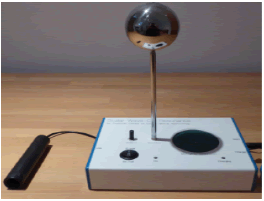
Figure 14: Tesla coil SW generator
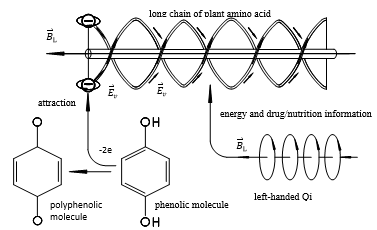
Figure 15: Transition from the phenolic to the chinoidal stage within plant polyphenolic molecules such as the anthocyanins generated by left-handed Qi
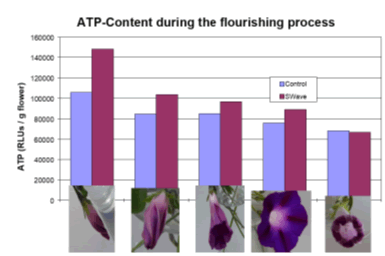
Figure 16: The ATP-level in the buds increased by 40% due to SW-treatment (10 mW, 90 sec, red columns in contrast to blue controls)
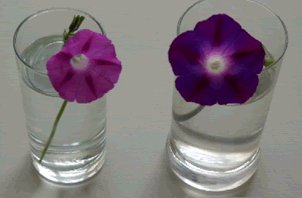
Figure 17: The SW-treated flower (right) shows a deep violet colour in contrast to the control (left, red), which reflects a change from a phenolic to a chinoidal stage of antocyanidines
Discussion
The concept of Qi in traditional Chinese medicine is essentially synonymous with SW and TF. As theoretical research and clinical applications of Qi deepen, the enigma surrounding Qi-related practices such as meditation, mindfulness, and fasting will gradually be unveiled. This will help us better understand these mysterious energies, improving healthcare methods and enhancing quality of life. It has been observed that the structure of negative Qi closely resembles that of DNA, suggesting numerous undisclosed connections between Qi and human energy systems. Further development in utilizing Qi for medical treatment and healthcare technology holds potential for revolutionary progress in medicine and healthcare. However, rigorous scientific validation along with multidisciplinary collaboration are essential prerequisites for ethical practice when employing Qi technology and instruments. By adhering to these measures we can truly harness the complexity of Qi for mankind’s benefit.
Conclusion
Our new models for wave equation and neutrino propagation model of Qi offer a fundamental explanation for the electromagnetic and energetic characteristics of Qi. Moreover, based on photon-positron/electron model, we demonstrate the generation mechanism of Qi and how Qi absorb huge zero-point vacuum energy in a vacuum from both wave and particle perspectives. A large number of experimental studies have confirmed that Qi can be absorbed by water and induce weakly alkaline, small molecular structured water with enhanced conductivity. What’s more, by attracting left-handed free electrons in the cellular fluid to move into cell membrane and improving mitochondrial efficiency and antioxidant effect, positive Qi can result in increasing mitochondrial ATP concentration and enhancing the energy of biological field of organisms, which unveil that Qi will potentially become a crucial aspect in future medical advancements.
Acknowledgement
None.
Conflict Of Interest
The authors whose names are listed immediately below certify that they have no affiliations with or involvement in any organization or entity with any financial interest (such as honoraria; educational grants; participation in speakers’ bureaus; membership, employment, consultancies, stock ownership, or other equity interest; and expert testimony or patent-licensing arrangements), or non-financial interest (such as personal or professional relationships, affiliations, knowledge or beliefs) in the subject matter or materials discussed in this manuscript. The authors whose names are listed immediately below report the following details of affiliation or involvement in an organization or entity with a financial or non-financial interest in the subject matter or materials discussed in this manuscript. Please specify the nature of the conflict on a separate sheet of paper if the space below is inadequate.
Funding
No specific funding was received for this study.
Author Contributions
All members have contributed equally to the writing of this manuscript.
References
- F.X. Hu, H.Y. Liu, Research on the essence of "Qi" and its measurement method-introducing professor Masami Sasaki's thoughts on "Qi" and experimental measurement method, Chi J Somatic Sci, 7(1997):74-76.
- Y.Z. Zeng, C.F. Shui, Hualing Press, 2014.
- W.A. Tiller, Science and human transformation: Subtle energies, intentionality and consciousness, Pavior Publishing, 10(1997):62-67.
- Masami S, The mystery of Qi, China workers press, 1994.
- C.H.Chien, J.J.Tsuei, S.C Lee, Effect of emitted bioenergy on biochemical function of cells, Am J Chin Med, 19(1991):285-292.
- S.C. Lee, X.G. Cai, W.C. Liang. The physical nature of crystalline Qi field--torison field, Buddhism and Sci, 2(2016):59-72.
- X.L. Jiang, J.Z. Lei, L.J. Han, TF and tapping the zero-point energy in an electrochemical system, J New Energy, 4(1999):93.
- TFs and their experimental manifestation, proc of the internat, scientific conf on new ideas in natural science.
- J.Z. Lei, X.L. Jiang, Electrochemical anomaly and theory of torison field, Sci Tech Review, 6(2000):1-3.
- W.C. Liang, S.C. Lee, Velocity, gyroscopic procession, and spin-curvature force, Phys Rev D, 87(2013):044024.
- S.C. Lee, The science of torsion field, 2020.
- J.C. Maxwell, A treatise on electricity & magnetism, Dover Publications,1(1893).
- H. Mill, Tesla's scalar fields still on beaming, Pure Energy System News, 4(2011):1-6.
- K. Meyl, Teil 1: Umdruck zur Vorlesung. Villingen-Schwenningen, Auflage, 15(1998):75-79.
- K. Meyl, Scalar waves: Theory and experiments, J Sci Exploration, 15(2001):199-205.
- J.L. Oschman, Energy medicine: The scientific basis, Elsevier Science, 2000:203-206.
- Bio-psycho-Spiritual effects of the energy enhancement system on adults.
- J.A. Ebbers, K. Meyl, Drug effects in yeast mediated by scalar waves. Med Sci, 8(2014):58-62.
- G. Rein, Biological interactions with scalar energy-cellular mechanisms of actions, proceedings seventh international association psychotronics research, 1988.
- K. Meyl, Magnetic wave transmission of drug effects about the waves, generated in the measurement set-up and used i.e. for anticancer-treatments. J US-China Med Sci, 16(2019):134-139.
- Z.X. Huang, Modern advances in neutrino research, Engineering Science, 10(2002):90-93.
- H.C. Sun, The mystery of neutrino, Changsha: Hunan education press, 1996.
- J. P.Yang, X. M.Chen, L. J.Tang, Neutrinos and the problem of its â??exceed velocity of lightâ?ÂÂ, J Natural Sci Hunan Normal Uni, 35(2012):27-33.
- Z. T. Gong, Theory of photon structure, Acta Photonica Sinica, 28(1999):1-10.
- J.S. Wu, C.Y. Wu, R.G. Zhang, Electric eddy current technology and application, South Central University Press, 2014.
- P. Meunier, L.D. Stephane, T. Leweke, Physics of vortex merging, Compets Rendus Physique, 6(2005):431-450.
- J. Fan, F.S. Yu, G. Zhang, Z.J. Tian, J. Liu, Two fundamental physics issues need paying great attention in wireless power transmission, Trans China Electro Soc, 28(2013):61-65.
- S.H. Guo, 2008, Higher education press, 121-158.
- X.L. Jiang, The 21st century is the zero-point energy century, Frontier Science, 4(2010):16-21.
- R. Don, Excitation and extraction of vacuum energy via EM-torsion field coupling theoretical model [J], J New Energy, 3(1998):130-131.
- Y. Aharonov, D. Bohm, Significance of electromagnetic potentials in the quantum theory, Phys Rev, 115(1959):485-491.
- A.Y. Ignatiev, G.C. Joshi, Electron positron annihilation into dirac magnetic monopole and antimonopole: The string ambiguity and the discrete symmetries, Modern Physics Letters A, 13(1998):2295-2304.
- H. Schnabl, K. Meyl, Longitudinal magnetic waves trigger higher ATP-levels and extend the aging process of plants, Biol Eng Med, 3(2018):1-4.
- H. Schnabl, K. Meyl, Anti-Aging by longitudinal magnetic waves: A new approach by modulating ATP-Levels, Biol Eng Med, 4(2019):1-5.
Copyright: © 2024 Jiang Jianzhong, et al. This is an open access article distributed under the terms of the Creative Commons Attribution License, which permits unrestricted use, distribution, and reproduction in any medium, provided the original work is properly cited

